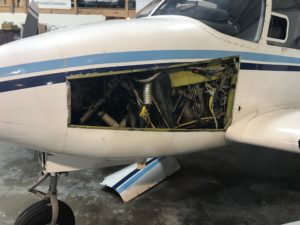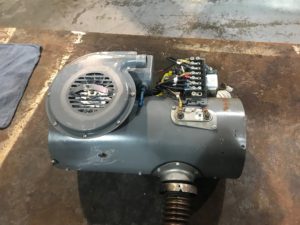Podcast: Play in new window | Download
Check out this picture… any idea what’s going on here?
Now that we are into cold weather seasons, it’s a good time to talk about aircraft heaters. They can be a necessary source of in-flight comfort, but if something goes wrong, they can also be surprising source of in-flight danger.
If your airplane has a combustion heater, make sure it’s maintained in a way that maximizes safety and reliability. Some heaters have AD’s that mandate certain inspections. Regardless of the AD’s, aircraft combustion heaters need regular and specific maintenance, to ensure proper and safe operation.
Two new AD’s have recently been issued on Southwind / Stewart Warner heaters. In the past, these heaters were not required by AD’s to have a pressure test at regular intervals, but one of the new AD’s DOES require a pressure test. And it’s a good thing, as you will find out when you listen to this episode.
The new AD’s are these:
AD 2017-15-05 (Replaces AD 69-13-03.) This AD is a one-time AD as long as the heater exhaust extension is stainless steel.
AD 2017-06-03 (Replaces AD 81-09-09.) This AD requires fairly extensive inspection, and pressure testing of the old Southwind / Stewart Warner aircraft combustion heaters. While it could be considered a cumbersome requirement, it really is a good thing, because if these heaters are not in good, safe, working condition, they can be flat-out dangerous! This is the AD that caused me to pressure test that heater in the picture above. And those bubbles are because the heater combustion tube has small holes in it, that can allow carbon monoxide gases to flow right into the airplane’s cabin during heater operation.
The interesting thing about this heater, is that unlike other heaters I’ve seen with cracks in them, this one ALMOST passed the pressure test. It was a slow leak, but I could not get it to meet the requirements of pressurizing the combustion tube with 6 pounds of air pressure, and having it maintain at least 4 pounds after 45 seconds.
So, it was a very good thing the heater was removed from this Piper Apache.
There are three options for complying with this AD. The first option is to do the required inspections and have the heater pass. The second option is to disable the heater in accordance with the AD requirements. The third option is to remove the heater in accordance with the AD requirements. We did the third option on this one, which meant revising the weight and balance also. Time will tell what the owner decides about overhauling the old heater, or buying a new one, or some other option. I’m just thankful that dangerous heater is out of that airplane!
Here’s what that Southwind heater, model 940D, looks like out of the airplane.
How about your airplane? Does it have a combustion heater? If so, PLEASE do whatever you need to, to make sure it is safe. Here is a sad accident report of a Cessna 402 crash back in May of 2012, that was caused by a malfunctioning combustion heater.
https://www.ntsb.gov/_layouts/ntsb.aviation/brief2.aspx?ev_id=20120511X83220&ntsbno=CEN12FA290&akey=1
If you have a combustion heater in your airplane, whether it’s a Janitrol, Southwind / Stewart Warner, or something else, verify that all AD’s are up to date. In addition, consider having a pressure test done, even if it’s not required by AD. It just might prevent a very dangerous situation some day.
If you’re just not sure about all this, take a look at the Harold Haskins website, and give Hal a call. He’s very knowledgeable, helpful, and easy to talk with.
http://www.haroldhaskinsinc.com/
Stay warm, be safe, and keep those aircraft combustion heaters in top-notch condition!
Thank you, Hal Haskins, for all your help and counsel you provided to me in this whole deal!





Great podcast Dean.
It brought back memories of the accident that killed Rickey Nelson, his fiancé, and his band. It happened over 30 years ago now; hard to believe it’s been that long ago.
I don’t think many people actually read the final NTSB report, with the comments from the pilot and co-pilot. But when you do read it, there doesn’t seem to be much doubt that the problems started with a faulty heater.
When I tried to look up the full NTSB report, the only document I could find that included the comments was pdf document from Emery-Riddle.
I don’t know if you allow URL addresses with these comments, but here’s the link: http://libraryonline.erau.edu/online-full-text/ntsb/aircraft-accident-summaries/AAR87-02S.pdf
Scroll down to page 32 of the pdf.
Thank you John, for sharing that. It’s sobering, but we need to be aware of these issues, so thanks. I will try to include this in a future episode and make the link available in the show notes. Thanks again!